Victoria's
Streetcar
Timeline
April 6 1889::The
National Electric Tramway and Lighting Company Limited was established
in Victoria.
February 22 1890::Victoria
completed the construction of a 5 mile streetcar system,
making it the third Canadian city to adopt the new transportation
system. The system comprised of 2 lines, or routes, and 4 cars.
May 26 1894::Point
Ellice Bridge collapsed when an overloaded streetcar was crossing,
sinking the streetcar and killing 55 passengers.
1
April 17 1896::BC's
3 streetcar systems were united as the Consolidated Railway Company.
April 3 1897::The
Consolidated Railway Company was sold and renamed the British Columbia
Electric Railway Company Limited.
December 5 1938::BC
Electric's franchise to provide Victoria transportation was set to
expire. By this time there existed 39 streetcars providing service
throughout Victoria, Esquimalt, Saanich, and Oak Bay.
February 14 1940::BC
Electric added a bus service to Victoria's streetcar system to
accommodate the high transport to and from Esquimalt's naval
barracks.
2
June 1 1944::The
streetcar system officially began its dismantling in Victoria, making
way for an all bus line.
July 5 1948::Victoria's
last streetcar took its last ride before all of the tracks were torn up.
Laying the tracks
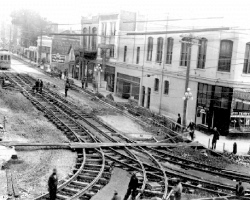 Tracks being laid at
Tracks being laid at
Douglas and Pandora
Before the streetcar's arrival in Victoria, the main form of public transportation was horse drawn carriages, known as hackney coaches. The introduction of the streecar meant Victorians could get around town more reliably and, by limiting the health hazard of manure, more safely. The Victoria streetcar system began with two primary lines, adding more
as needed as time went on. Line number one began at outer wharf,
continuing "via Erie, St. Lawrence, and Superior streets, to Government
Street (Birdcage Walk, at its southern end), then east on Yates Street
to Douglas Street, and north on Douglas to the Fountain (Hillside
Avenue)."
3
This is the line that the 1907
streetcar ride footage
follows, however it is heading in the opposite direction beginning
south on Douglas Street, turning west on Yates, and finally turning south
again onto Government Street.
Line number two
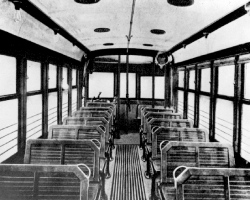 Inside the streetcar
Inside the streetcar
The second line began at the car barn (just south of
Rock Bay Bridge) heading south on Store Street, then east on Johnson
Street to Government Street, south on Government to Fort Street, and
east on Fort, past the palatial home (at 1501) of D.W. Higgins,
Regent's Park, to Jubilee Hospital (under construction at the time) at
Richmond Road, the city's limits.
4
Small change
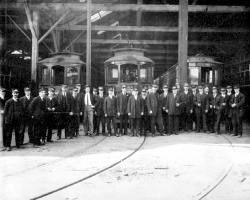 In front of the car barn
In front of the car barn
The initial fare to ride one of Victoria's streetcars was 5
cents.
5 In
May 1 1896, the National
Electric Tramway and
Lighting Company Limited was bought out by Frank Stillman Barnard, who
owned the other 2 BC streetcar systems.
6 The sale of the streetcar was upsetting for Victorians because they could no longer have any say or control over it.
Trolley goes to war
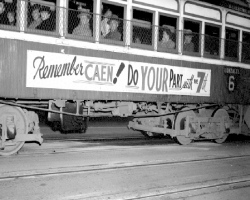 Victory loan poster
Victory loan poster
Although the BC Electric Railway Company's franchise was set to expire in 1938,
the company extended it to continue to provide Victoria with transportation until
some other system could takeover completely.
7
As Canada entered the war, Victoria's
streetcar system was
in high enough demand that BC Electric added an electric bus service.
Streetcar interiors and exteriors were emblazoned with victory posters to
encourage Victorians to do their part. Victoria's streetcars and buses
took part in blackout attempts by curtailing their schedules, blacking
out headlights, and using a skip-stop system to accommodate gas
rationing.
8 The
war also enabled women
to work as conductors
and guides for the streetcars.
The end of the line
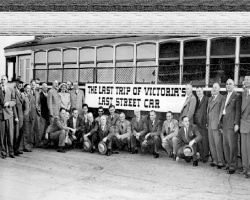 The last ride
The last ride
The BC Electric Company was no longer the only transportation company
in town. Blue Line Transit and Vancouver Island Coach Lines both
provided their own bus services to the city. BC Electric purchased Blue
Line on September 3,1946 and planned to discontinue its trolley
services completely, using only buses.
9
By 1950,
BC Electric also
acquired Vancouver Island Coach Lines. Gradually, diesel buses
replaced the electric buses, making the electric transportation era in Victoria little more than a memory.
top
1 Henry
Ewert. Victoria's
Streetcar Era (Victoria: Sono Nis Press, 1992), 33.
2
Ewert, 90.
3
Ewert, 16.
4
Ewert, 16-17.
5
Henry Ewert. The Story
of the B.C. Electric
Railway Company (North
Vancouver: Whitecap Books Ltd., 1986), 13.
6
Ewert, Victoria's
Streetcar,
33-34.
7
Ewert, Victoria's
Streetcar,
87.
8
Ewert, Victoria's
Streetcar,
91-92.
9
Ewert, Victoria's
Streetcar,
126.
 Tracks being laid at
Tracks being laid at Inside the streetcar
Inside the streetcar
 In front of the car barn
In front of the car barn
 Victory loan poster
Victory loan poster
 The last ride
The last ride